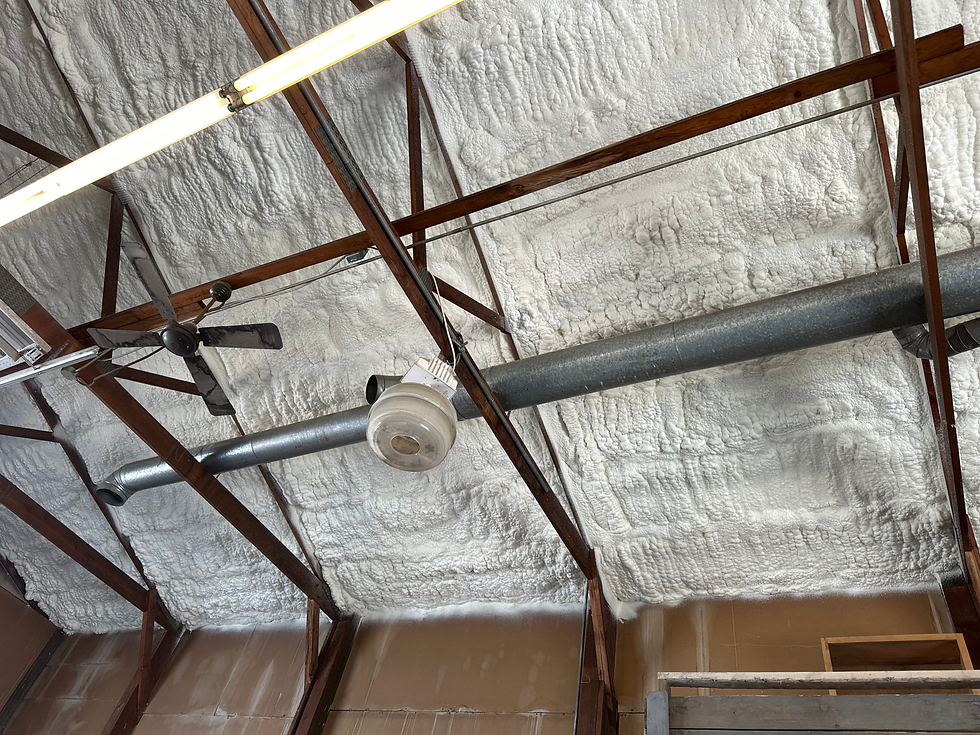Roof & Attic Spray Foam in Kansas Require R-49
- Advanced Seal Kansas
- Sep 10
- 3 min read

Attic Insulation for Kansas Climates
Attics and rooflines are the most critical parts of any Kansas home or building when it comes to comfort and energy savings. Without proper insulation, attics quickly become the main source of heat loss in winter and heat gain in summer, driving up energy bills and making it hard to keep rooms comfortable. Kansas building code now requires at least R-49 attic insulation, whether you’re finishing a traditional home, shop or modern barndominium.
Spray foam insulation is one of the most effective solutions for meeting and exceeding these standards. Unlike loose-fill or batt insulation, spray foam forms a seamless barrier that fills every nook and cranny, eliminating drafts and blocking unwanted moisture. This is especially valuable for homes with complex rooflines, cathedral ceilings or irregular framing, which can leave gaps when using traditional materials.
In barndominiums and metal buildings, closed cell spray foam bonds directly to the roof deck or metal panels. It provides a vapor barrier, prevents condensation and helps maintain even indoor temperatures regardless of outdoor conditions. Open cell spray foam is another option for vented attics, offering excellent air sealing and sound dampening.
One additional benefit of spray foam insulation is its ability to increase the overall structural strength of the roof. Closed cell foam, in particular, can add rigidity to roof decks and framing, making the structure more resistant to Kansas’s strong winds and occasional severe weather. This means spray foam does more than keep you comfortable; it helps protect your investment from the elements.
Another important fact is that well-insulated attics and rooflines also reduce the risk of ice dam formation. In Kansas winters, warm air escaping into the attic can melt snow on the roof, causing water to refreeze at the eaves and form damaging ice dams. By air sealing and insulating with spray foam, you can maintain a colder roof surface, minimizing this risk and preventing costly repairs.
Vented vs. Unvented Roofs and Code Compliance
Kansas homeowners and builders have a choice between vented and unvented attic assemblies. Vented attics use insulation on the attic floor with vents at the soffits and ridge to promote airflow. This traditional approach works well with blown-in insulation or open cell spray foam, but it is crucial to block every possible air leak from the living area below.
Unvented attics, now allowed under Kansas code with the right insulation, place spray foam directly against the roof sheathing. This method is ideal for barndominiums, metal buildings and homes with little attic space. Closed cell spray foam is applied to the underside of the roof deck, providing a strong vapor barrier and thermal shield.
All spray foam applications in attics and rooflines must include proper ignition barriers in areas where the foam is exposed. Kansas inspectors will check for fire-resistant coverings like drywall or approved coatings. Our team at Advanced Seal Kansas is familiar with these requirements and handles every step, from application to code documentation.
See how we help customers with attic insulation in Kansas or explore our spray foam insulation services for homes and businesses.
Ready for a more comfortable home, barndominium or shop with lower utility bills? Trust Advanced Seal Kansas for expert spray foam application, code compliance and honest local service.
Contact us today to schedule a free estimate in Wichita, Dodge City, Hutchinson and throughout in Kansas.




Comments